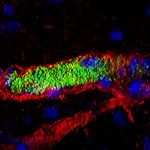Link to Pubmed [PMID] – 21311024
Science 2011 Feb;331(6018):778-82
The Gram-negative bacterium Neisseria meningitidis asymptomatically colonizes the throat of 10 to 30% of the human population, but throat colonization can also act as the port of entry to the blood (septicemia) and then the brain (meningitis). Colonization is mediated by filamentous organelles referred to as type IV pili, which allow the formation of bacterial aggregates associated with host cells. We found that proliferation of N. meningitidis in contact with host cells increased the transcription of a bacterial gene encoding a transferase that adds phosphoglycerol onto type IV pili. This unusual posttranslational modification specifically released type IV pili-dependent contacts between bacteria. In turn, this regulated detachment process allowed propagation of the bacterium to new colonization sites and also migration across the epithelium, a prerequisite for dissemination and invasive disease.

